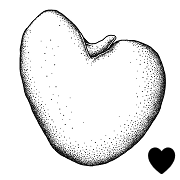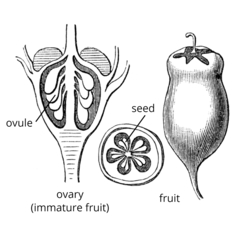Content is from Kirkbride et al. 2006Kirkbride et al. 2006:
Kirkbride JH, Jr, Gunn CR, and Dallwitz MJ. 2006. Family guide for fruits and seeds, vers. 1.0. Accessed September 2020-January 2022. URL: https://nt.ars-grin.gov/seedsfruits/keys/frsdfam/index.cfm ., without modification.
Updates are forthcoming.
 and mesocarpmesocarp:
and mesocarpmesocarp: absent and endocarpendocarp:
absent and endocarpendocarp: exposed.
exposed.
Fruits: Pistil(s) compound; 1; 1-pistillate; with carpels united. Fruit pericarpium; simple; drupedrupe:
(indehiscent drupe) a fleshy, indehiscent fruit with one more hard pits enclosing seeds, derived from single, superior, simple or compound ovary; (dehiscent drupe) a fruit with a dry or fibrous to fleshy or leathery outer husk that early to tardily breaks apart (or opens), exposing one or more nutlike pits enclosing the seeds ; without persistent central column; not within accessory organ(s); 1-seeded to more than 1 but less than 10-seeded; 1–2-seeded; pea to mango size; 3–4 cm long; with (4–)5(–7)-carpellate (carpels 5 also have woodywoody:
; without persistent central column; not within accessory organ(s); 1-seeded to more than 1 but less than 10-seeded; 1–2-seeded; pea to mango size; 3–4 cm long; with (4–)5(–7)-carpellate (carpels 5 also have woodywoody:
texture—consisting mainly of indurate lignified tissues, characteristic of or resembling wood
wings); with carpels united; with carpels remaining united at maturity; without sterilesterile:
lacking male and/or female reproductive parts; also, not producing fruit or seed
 carpels; not sulcatesulcate:
carpels; not sulcatesulcate:
surface relief—having one or more elongate, relatively narrow and shallow depressions or grooves ; apexapex:
; apexapex:
the point farthest from the point of attachment, or the "tip" of an organ not beaked; indehiscentindehiscent:
not beaked; indehiscentindehiscent:
not opening on its own, as in a fruit
 . Epicarpepicarp:
. Epicarpepicarp:
outer layer of fruit wall or pericarp, if divided into layers; note here used synonymously with exocarp brown (all shades), or black and brown (all shades); dulldull:
brown (all shades), or black and brown (all shades); dulldull:
reflecting only a low proportion of incident light, with no apparent sheen ; durable; without armature; smooth, or not smooth; rugoserugose:
; durable; without armature; smooth, or not smooth; rugoserugose:
wrinkled , or tuberculatetuberculate:
, or tuberculatetuberculate:
surface relief—bearing small, warty, swelling, rounded, or variously shaped projections ; without wing(s); without apicalapical:
; without wing(s); without apicalapical:
at or pertaining to the end of the seed or fruit distal from its point of attachment (i.e., base)
respiratory hole. Mesocarpmesocarp:
the middle layer of the pericarp, if divided into layers present; fleshy, or fibrousfibrous:
present; fleshy, or fibrousfibrous:
texture—long, flexible threads, thicker than hairs, that densely cover and obscure the surface ; composed of 1 unified layer; without lactiform cavity system; & endocarpendocarp:
; composed of 1 unified layer; without lactiform cavity system; & endocarpendocarp:
the inner layer of the pericarp, if divided into layers sharply differentiated. Endocarpendocarp:
sharply differentiated. Endocarpendocarp:
the inner layer of the pericarp, if divided into layers present; not separating from exocarpexocarp:
present; not separating from exocarpexocarp:
outer layer of fruit wall or pericarp, if divided into layers; note here used synonymously with epicarp ; woodywoody:
; woodywoody:
texture—consisting mainly of indurate lignified tissues, characteristic of or resembling wood
; not splitting into 1-seeded pyrenes; stone unilocular, or plurilocular; stone 2–6-loculate; smooth, or not smooth (blisterpod); with operculumoperculum:
a dehiscent cap (or lid) of a seed or fruit that opens during germination or dehiscence , or without operculumoperculum:
, or without operculumoperculum:
a dehiscent cap (or lid) of a seed or fruit that opens during germination or dehiscence ; with numerous resinous secretory cavities, or without secretory cavities; without mechanism for seedling escape; without grooves; without longitudinallongitudinal:
; with numerous resinous secretory cavities, or without secretory cavities; without mechanism for seedling escape; without grooves; without longitudinallongitudinal:
of or relating to length or the lengthwise dimension
ridges. Funiculusfuniculus:
(alt. funicle) stalk connecting the ovule (later seed) to the ovary (later fruit) placenta short; short without seed bearing hookswith hooks:
short; short without seed bearing hookswith hooks:
bristles or spines with curved or backwards pointing tips, or with secondary bristles along their length (retinacula); not persisting in fruit after seed shed.
(retinacula); not persisting in fruit after seed shed.
Seeds: Arilaril:
(broad sense) appendicular structure that wholly or partly envelops a seed and is produced from or a modification of the funicle, raphe, or outer integument; usually fleshy or pulpy, sometimes spongy or tufted-capillate, often brightly colored absent. Seed larger than minute; 25 to less than 50 mm long; 32 mm long; straight, or oblongoblong:
absent. Seed larger than minute; 25 to less than 50 mm long; 32 mm long; straight, or oblongoblong:
2D shape—much longer than broad with nearly parallel sides, corners are rounded ; not bowl shaped; not nutlike; without winglike beakbeak:
; not bowl shaped; not nutlike; without winglike beakbeak:
a usually firm, terminal appendage, sometimes tapered ; without caudatecaudate:
; without caudatecaudate:
tapering to a long, tail-like appendage appendage(s); at maturity with food reserves; with endosperm; without canavanine. Sarcotestasarcotesta:
appendage(s); at maturity with food reserves; with endosperm; without canavanine. Sarcotestasarcotesta:
pulpy or fleshy outer layer of the seed coat, simulates aril absent. Testatesta:
absent. Testatesta:
seed coat
 present, or absent; without embryo surrounded and capped by viscid tissue; without fleshy or leatheryleathery:
present, or absent; without embryo surrounded and capped by viscid tissue; without fleshy or leatheryleathery:
texture—moderately thick, tough, and very pliable
layer over hard layer; loose; surface unsmooth; surface with merged raised features; surface reticulatereticulate:
surface relief—netted, raised walls or concave grooves forming a net-like surface pattern with flat, concave, or convex interspaces ; without crease or line separating cotyledons from hypocotyl-radicle; without notch along margin where cotyledons from hypocotyl-radicle tip approach each other; without glands; without bristles; glabrousglabrous:
; without crease or line separating cotyledons from hypocotyl-radicle; without notch along margin where cotyledons from hypocotyl-radicle tip approach each other; without glands; without bristles; glabrousglabrous:
without hairs
; without wings; without collar; without operculumoperculum:
a dehiscent cap (or lid) of a seed or fruit that opens during germination or dehiscence ; colored; monochrome; brown (all shades) (at least); not becoming mucilaginousmucilaginous:
; colored; monochrome; brown (all shades) (at least); not becoming mucilaginousmucilaginous:
resembling mucilage; moist and sticky
when wetted; surrounding food reserve. Endosperm fleshy; smooth; with oils; without fatty acid containing cyclopropene; without apicalapical:
at or pertaining to the end of the seed or fruit distal from its point of attachment (i.e., base)
lobes; without chlorophyll; without isodiametric faceted surface; without odor. Embryo differentiated from food reserve; well developed; 1 per seed; partially filling testatesta:
seed coat
 (with food reserve); at one end of seed not extending into a depression or cup; axileaxile:
(with food reserve); at one end of seed not extending into a depression or cup; axileaxile:
on or of the axis
and centric; foliatefoliate:
appearing leaf-like
; with spatulatespatulate:
2D shape—like a spatula; rounded at the apex, with base long and tapered; (of embryo) embryo is straight and axile and centric with the cotyledons expanded to form the shape of a spatula or spoon; (of cotyledons) cotyledons expanded and wider than the stalk but not invested into the stalk cotyledons; straight, or C-shapedC-shaped:
cotyledons; straight, or C-shapedC-shaped:
2D-shape—semiannulate, curved into the shape of the letter 'C'
; parallel to seed length; with cotyledons abruptly connected to hypocotyl-radicle; without coleorhiza; without simmondsin; without stomata; not green; with 2 or more cotyledons. Cotyledons 2; well developed; 0.5–0.7 times length of embryo; somewhat to significantly wider than hypocotyl-radicle; 1.5 times wider than hypocotyl-radicle; not concealing hypocotyl-radicle; foliaceous; hemispheric; smooth; with apicesapex:
the point farthest from the point of attachment, or the "tip" of an organ entire; with margins separate; basally cordatecordate:
entire; with margins separate; basally cordatecordate:
2D shape—heart-shaped, with attachment at or near the broad end (compare obcordate) , or entire; equal in size; not punctatepunctate:
, or entire; equal in size; not punctatepunctate:
surface relief—dotted with pits or with translucent, sunken glands or with colored dots, similar to pitted dotted. Hypocotyl-radicle well developed; straight; not thickened.
dotted. Hypocotyl-radicle well developed; straight; not thickened.
Literature specific to this family: Cuatrecasas, J. 1961. A taxonomic revision of the Humiriaceae. Contr. U.S. Natl. Herb. 35(2):1–214; Ducke, A. 1937. Plantes nouvelles ou peu connues de le région Amazonienne (X serie). Arq. Inst. Biol. Veg. 4:24–31; Boesewinkel, F.D. 1985. The ovuleovule:
organ that contains the egg and after fertilization, becomes the seed and seed of Humiria balsamifera (Aubl.) St. Hil. Acta Bot. Neerl. 34:183–191.
and seed of Humiria balsamifera (Aubl.) St. Hil. Acta Bot. Neerl. 34:183–191.
General references: Cronquist, A. 1981. An integrated system of classification of flowering plants, 1,262 p. Columbia University Press, New York, Engler, A. & K. Prantl. 1924 and onward. Die Natürlichen Pflanzenfamilimien. W. Engelman, Leipzig, Gunn, C.R. & J.V. Dennis. 1976. World guide to tropical drift seeds and fruits, 240 pp. The New York Times Book Co., New York, Gunn, C.R., J.H. Wiersema, C.A. Ritchie, & J.H. Kirkbride, Jr. 1992 & amendments. Families and genera of Spermatophytes recognized by the Agricultural Research Service. Techn. Bull. U.S.D.A. 1796:1–500, Mabberley, D.J. 1987. The plant-book, 706 p. Cambridge University Press, Cambridge, Roosmalen, M.G.M. van. 1985. Fruits of the Guianan flora, 483 pp. Institute of Systematic Botany, Wageningen Agricultural University. Drukkerij Veenman B.V., Wageningen, and Spjut, R.W. 1994. A systematic treatment of fruit types. Mem. New York Bot. Gard. 70:1–182.